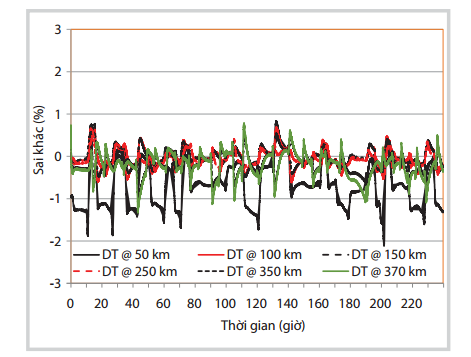Dynamic modelling of transients in high-pressure natural gas pipelines
Abstract
Natural gas is mainly transported undersea in large-scale and long distance pipelines. Prediction of the gas pipeline temperature and pressure profiles is very important in the operation of natural gas transport, especially in case of accidents of pipeline upstream or downstream. An analytical method for calculation of these profiles has been developed and this method of implicit high order finite difference scheme could be a good choice to build the software for simulation of dynamic gas pipeline. In this work, an implicit finite difference scheme has been used to solve the energy equation, the continuity and momentum equation. The flow model was validated by comparing the computed results to commercial software for an off shore natural gas pipeline, with defined natural gas composition. The modelled results showed good agreement with the commercial software (with an average absolute deviation of 0.41% on pressure, 0.39% on flow and 0.29% on temperature).
References
2. Thủ tướng Chính phủ. Phê duyệt Quy hoạch tổng thể phát triển ngành công nghiệp khí Việt Nam giai đoạn đến năm 2015, định hướng đến năm 2025. Quyết định số 459/QĐ-TTg. 30/3/2011.
3. L.I.Langelandsvik, W.Postvoll, B.Aarhus, K.K.Kaste. Accurate calculations of pipeline transport capacity. Proceedings to 24th World Gas Conference, Buenos Aires, Argentina. 2009.
4. A.R.D.Thorley, C.H.Tiley. Unsteady and transient flow of compressible fluids in pipelines - a review of theoretical and some experimental studies. International Journal of Heat and Fluid Flow. 1987; 8(1): p. 3 - 15.
5. M.Poloni, D.E.Winterbone, J.R.Nichols. Comparison of unsteady flow calculations in a pipe by the method of characteristics and the two-step differential Lax-Wendroff method. International Journal of Mechanical Sciences. 1987; 29(5): p. 367 - 378.
6. J.F.Helgaker, T.Ytrehus. Coupling between continuity/momentum and energy equation in 1D gas flow. Energy Procedia. 2012; 26: p. 82 - 89.
7. P.Wang, B.Yu, Y.Deng, Y.Zhao. Comparison study on the accuracy and efficiency of the four forms of hydraulic equation of a natural gas pipeline based on linearized solution. Journal of Natural Gas Science and Engineering. 2015; 22: p. 235 - 244.
8. C.Bisgaard, H.H.Sørensen, S.Spangenberg. A finite element method for transient compressible flow in pipelines. International Journal for Numerical Methods in Fluids. 1987; 7(3): p. 291 - 303.
9. A.J.Osiadacz, M.Yedroudj. A comparison of a finite element method and a finite difference method for transient simulation of a gas pipeline. Applied Mathematical Modelling. 1989; 13(2): p. 79 - 85.
10. L.Gato, J.Henriques. Dynamic behaviour of high- pressure natural-gas flow in pipelines. International Journal of Heat and Fluid Flow. 2005; 26(5): p. 817 - 825.
11. T.Kiuchi. An implicit method for transient gas flows in pipe networks. International Journal of Heat and Fluid Flow. 1994; 15(5): p. 378 - 383.
12. M.Behbahani-Nejad, A.Bagheri. The accuracy and efficiency of a MATLAB-Simulink library for transient flow simulation of gas pipelines and networks. Journal of Petroleum Science and Engineering. 2010; 70(3): p. 256 - 265.
13. G.Greyvenstein. Animplicitmethodfortheanalysis of transient flows in pipe networks. International journal for Numerical Methods in Engineering. 2002; 53(5): p. 1127 - 1143.
14. M.Abbaspour, K.Chapman. Nonisothermal transient flow in natural gas pipeline. Journal of Applied Mechanics. 2008; 75(3).
15. A.J.Osiadacz, M.Chaczykowski. Comparison of isothermal and non-isothermal pipeline gas flow models. Chemical Engineering Journal. 2001; 81(1): p. 41 - 51.
16. L.I.Langelandsvik. Modeling of natural gas transportand friction factor for large-scale pipelines: Laboratory experiments and analysis of operational data. 2008.
17. L.I.Langelandsvik, S.Solvang, M.Rousselet, I.N.Metaxa and M.J.Assael. Dynamicviscositymeasurements of three natural gas mixtures-comparison against prediction models. International Journal of Thermophysics. 2007; 28(4): p. 1120 - 1130.
18. J.Ramsen, S.-E.Losnegard, L.I.Langelandsvik, A.J.Simonsen and W.Postvoll. Important aspects of gas temperature modeling in long subsea pipelines. Pipeline Simulation Interest Group. 2009.
19. M.Chaczykowski. Sensitivity of pipeline gas flow model to the selection of the equation of state. Chemical Engineering Research and Design. 2009; 87(12): p. 1596 - 1603.
20. M.Chaczykowski. Transient flow in natural gas pipeline - The effect of pipeline thermal model. Applied Mathematical Modelling. 2010; 34(4): p. 1051 - 1067.
21. J.F.Helgaker, B.Müller, T.Ytrehus. Transient flow in natural gas pipelines using implicit finite difference schemes. Journal of Offshore Mechanics and Arctic Engineering. 2014; 136(3).
22. C.F.Colebrook, T.Blench, H.Chatley, E.Essex, J.Finniecome, G.Lacey, J.Williamson, and G.Macdonald. Turbulent flow in pipes, with particular reference to the transition region between the smooth and rough pipe laws. Journal of the Institution of Civil engineers. 1939; 11(4): p. 133 - 156.
23. J.O.Valderrama. The state of the cubic equations of state. Industrial & Engineering Chemistry Research. 2003; 42(8): p. 1603 - 1618.
24. G.Soave. Equilibrium constants from a modified redlich-kwong equation of state. Chemical Engineering Science. 1972; 27(6): p. 1197 - 1203.
25. D.Y.Peng, D.B.Robinson. A new two-constant equation of state. Industrial & Engineering Chemistry Fundamentals. 1976; 15(1): p. 59 - 64.
26. M.Luskin. An approximation procedure for nonsymmetric, nonlinear hyperbolic systems with integral boundary conditions. SIAM Journal on Numerical Analysis. 1979; 16(1): p. 145 - 164.

1. The Author assigns all copyright in and to the article (the Work) to the Petrovietnam Journal, including the right to publish, republish, transmit, sell and distribute the Work in whole or in part in electronic and print editions of the Journal, in all media of expression now known or later developed.
2. By this assignment of copyright to the Petrovietnam Journal, reproduction, posting, transmission, distribution or other use of the Work in whole or in part in any medium by the Author requires a full citation to the Journal, suitable in form and content as follows: title of article, authors’ names, journal title, volume, issue, year, copyright owner as specified in the Journal, DOI number. Links to the final article published on the website of the Journal are encouraged.




